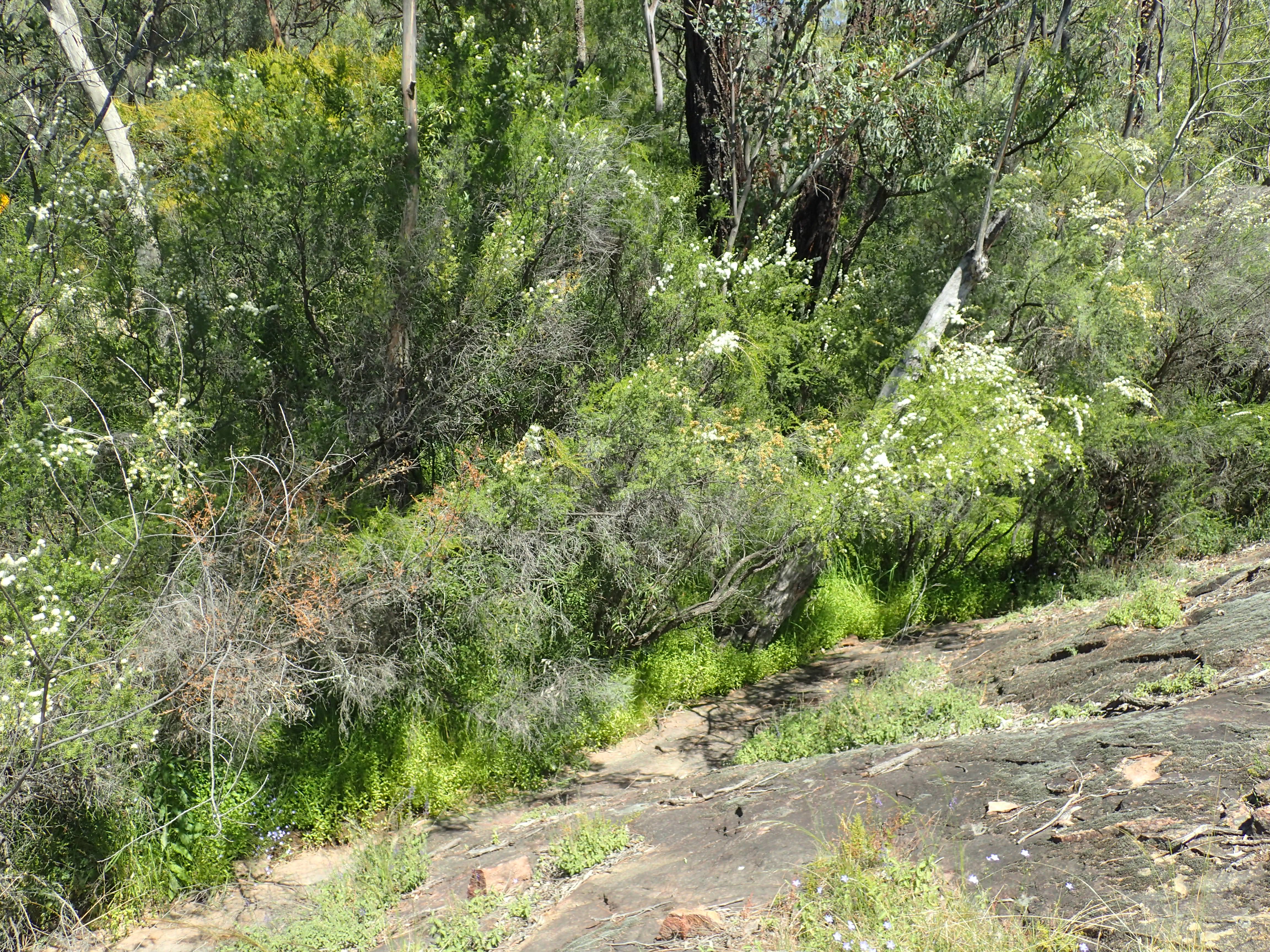Kunzea Occidentalis on:
[Wikipedia]
[Google]
[Amazon]
 ''Kunzea occidentalis'' is a flowering plant in the myrtle family,
''Kunzea occidentalis'' is a flowering plant in the myrtle family,
 ''Kunzea occidentalis'' is a flowering plant in the myrtle family,
''Kunzea occidentalis'' is a flowering plant in the myrtle family, Myrtaceae
Myrtaceae, the myrtle family, is a family of dicotyledonous plants placed within the order Myrtales. Myrtle, pōhutukawa, bay rum tree, clove, guava, acca (feijoa), allspice, and eucalyptus are some notable members of this group. All speci ...
and is endemic to a western New South Wales. It is a shrub with narrow leaves and small groups of white flowers on leafy side-branches. It is distinguished from the similar ''Kunzea ambigua
''Kunzea ambigua'', commonly known as white kunzea, poverty bush or tick bush, is a plant in the myrtle family, Myrtaceae and is found mainly on sandstone soils in eastern Australia. Growing up to high and wide, it bears small white flowers in ...
'' by the flanges on the sides of its young branches.
Description
''Kunzea occidentalis'' is a shrub which usually grows to a height of with its young branches having its leaf bases as raised, spongy, cream-coloured tissue. The leaves are arranged alternately, linear to narrow lance-shaped, long and about wide with a petiole usually less than long. The flowers are arranged singly or in groups of up to six near the ends of the branches. There are egg-shaped to ellipticbract
In botany, a bract is a modified or specialized leaf, especially one associated with a reproductive structure such as a flower, inflorescence axis or cone scale. Bracts are usually different from foliage leaves. They may be smaller, larger, or of ...
s about long and wide and smaller paired bracteoles at the base of the flowers. The floral cup
In angiosperms, a hypanthium or floral cup is a structure where basal portions of the calyx, the corolla, and the stamens form a cup-shaped tube. It is sometimes called a floral tube, a term that is also used for corolla tube and calyx tube. It ...
is glabrous and long with the sepal lobes long and glabrous. The petal
Petals are modified Leaf, leaves that surround the reproductive parts of flowers. They are often advertising coloration, brightly colored or unusually shaped to attract pollinators. All of the petals of a flower are collectively known as the ''c ...
s are white, broadly egg-shaped to almost round and about long. There are about 50-60 stamen
The stamen (plural ''stamina'' or ''stamens'') is the pollen-producing reproductive organ of a flower. Collectively the stamens form the androecium., p. 10
Morphology and terminology
A stamen typically consists of a stalk called the filame ...
s which are long. Flowering occurs in October and November.
Taxonomy and naming
''Kunzea occidentalis'' was first formally described in 2016 by Hellmut R. Toelken and the description was published in '' Journal of the Adelaide Botanic Garden''. Thespecific epithet
In taxonomy, binomial nomenclature ("two-term naming system"), also called nomenclature ("two-name naming system") or binary nomenclature, is a formal system of naming species of living things by giving each a name composed of two parts, bot ...
(''occidentalis'') is a Latin word meaning "western" referring to the distribution of this species on the western side of the Great Dividing Range
The Great Dividing Range, also known as the East Australian Cordillera or the Eastern Highlands, is a cordillera system in eastern Australia consisting of an expansive collection of mountain ranges, plateaus and rolling hills, that runs rough ...
.
Distribution and habitat
This kunzea grows in heath and forest, mainly in rocky places and in creek beds. It is found on the western slopes of the Great Dividing Range and is common in the Warrumbungle andMount Kaputar
Mount Kaputar, a mountain with an elevation of above sea level, is located near Narrabri in northern New South Wales. It is part of the Nandewar Range and has been preserved within the Mount Kaputar National Park. The mountain is a prominent l ...
national parks.
References
{{Taxonbar, from=Q65941625occidentalis
This list of Latin and Greek words commonly used in systematic names is intended to help those unfamiliar with classical languages to understand and remember the scientific names of organisms. The binomial nomenclature used for animals and plants i ...
Flora of New South Wales
Myrtales of Australia
Plants described in 2016
Endemic flora of Australia
Taxa named by Hellmut R. Toelken